Hths 1111 - Study guides, Class notes & Summaries
Looking for the best study guides, study notes and summaries about Hths 1111? On this page you'll find 10 study documents about Hths 1111.
All 10 results
Sort by
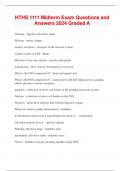 Popular
Popular
-
HTHS 1111 Midterm Exam Questions and Answers 2024 Graded A
- Exam (elaborations) • 20 pages • 2024
-
- $12.99
- 1x sold
- + learn more
Afferent - Signal to the brain, input Efferent - motor, output sensory receptors - receptors of the nervous system Control center of CNS - Brain Effectors of nervous system - muscles and glands transduction - How sensory information is received What is the CNS composed of? - brain and spinal cord What is the PNS composed of? - cranial nerves III-XII, Spinal nerves, ganglia, enteric plexuses, sensory receptors ganglion - collection of nerve cell bodies in the peripheral ne...

-
Weber HTHS 1111 Final Exam Study Guide Graded A 2024
- Exam (elaborations) • 61 pages • 2024
-
- $14.49
- + learn more
The heart is positioned in which of the following cavities? diaphragmatic dorsal mediastinum pleural pelvic diaphragmatic Which organ or structure is lateral to the heart? esophagus lung sternum vertebral column lung The semilunar valves are between the: atria and atrioventricular valves atria and coronary sinus ventricles and vena cavae ventricles and the pulmonary trunk and aorta ventricles and the pulmonary trunk and aorta Blood flows from the right atrium, thro...
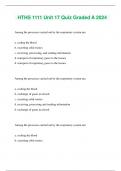
-
HTHS 1111 Unit 17 Quiz Graded A 2024
- Exam (elaborations) • 19 pages • 2024
-
- $14.99
- + learn more
Among the processes carried out by the respiratory system are: a. coding the blood b. excreting solid wastes c. receiving, processing, and sending information d. transport of respiratory gases to the tissues d. transport of respiratory gases to the tissues Among the processes carried out by the respiratory system are: a. cooling the blood b. exchange of gases at alveoli c. excreting solid wastes d. receiving, processing and sending information b. exchange of gases at alveoli ...
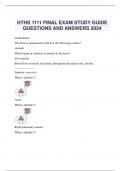
-
HTHS 1111 FINAL EXAM STUDY GUIDE QUESTIONS AND ANSWERS 2024
- Exam (elaborations) • 78 pages • 2024
-
- $15.99
- + learn more
mediastinum The heart is positioned in which of the following cavities? sternum Which organ or structure is anterior to the heart? left ventricle Blood flows from the left atrium, through the bicuspid valve, into the ______________. Superior vena cava What is labeled 1? Aorta What is labeled 2? Right pulmonary arteries What is labeled 3? Left pulmonary arteries What is labeled 4? Right pulmonary veins What is labeled 5? Pulmonary trunk What is labeled 6? Pulmo...
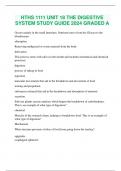
-
HTHS 1111 UNIT 18 THE DIGESTIVE SYSTEM STUDY GUIDE 2024 GRADED A
- Exam (elaborations) • 26 pages • 2024
-
- $14.99
- + learn more
Occurs mainly in the small intestines. Nutrients move from the GI tract to the bloodstream absorption Removing undigested or waste material from the body defecation This process starts with saliva in the mouth and includes mechanical and chemical processes digestion process of taking in food ingestion muscular movements that aid in the breakdown and movement of food mixing and propulsion substances released that aid in the breakdown and absorption of nutrients secretion Salivary glan...
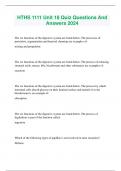
-
HTHS 1111 Unit 18 Quiz Questions And Answers 2024
- Exam (elaborations) • 16 pages • 2024
-
- $12.99
- + learn more
The six functions of the digestive system are listed below. The processes of peristalsis, segmentation and haustral churning are examples of: mixing and propulsion The six functions of the digestive system are listed below. The process of releasing stomach acids, mucus, bile, bicarbonate and other substances are examples of: secretion The six functions of the digestive system are listed below. The process by which intestinal cells absorb glucose on their luminal surface and transfer ...
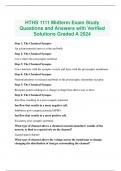
-
HTHS 1111 Midterm Exam Study Questions and Answers with Verified Solutions Graded A 2024
- Exam (elaborations) • 29 pages • 2024
-
- $15.49
- + learn more
Step 1: The Chemical Synapse An action potential arrives at the end bulb. Step 2: The Chemical Synapse Ca++ enters the presynaptic terminal. Step 3: The Chemical Synapse Ca++ interacts with the synaptic vesicle and fuses with the presynaptic membrane. Step 4: The Chemical Synapse Neurotransmitter is released and binds to the postsynaptic transmitter receptor. Step 5: The Chemical Synapse Receptor protein undergoes a change in shape that allows ions to flow. Step 6: The Chemical Synapse...
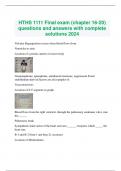
-
HTHS 1111 Final exam (chapter 16-20) questions and answers with complete solutions 2024
- Exam (elaborations) • 33 pages • 2024
-
- $15.49
- + learn more
Valvular Regurgitation occurs when blood flows from: Ventricles to atria Location of systemic arteries in lower body Norepinephrine, epinephrine, antidiuretic hormone, angiotensin II and endothelium-derived factors are all examples of: Vasoconstrictors Location of S-T segment on graph Blood flows from the right ventricle, through the pulmonary semilunar valve, into the______ Pulmonary trunk Sympathetic innervation of the heart activates ______ receptors which _____ the heart rate. ...
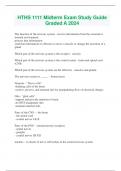
-
HTHS 1111 Midterm Exam Study Guide Graded A 2024
- Exam (elaborations) • 15 pages • 2024
-
- $14.49
- + learn more
The function of the nervous system - receive information from the external or internal environment process that information send that information to effectors to move a muscle or change the secretion of a gland Which part of the nervous system is the receptor - sensory Which part of the nervous system is the control center - brain and spinal cord (CNS) Which part of the nervous system are the effectors - muscles and glands The nervous system is _____. - homeostasis Neurons - "N...
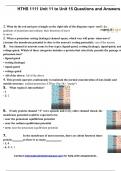
-
HTHS 1111 Unit 11 to Unit 15 Questions and Answers
- Exam (elaborations) • 29 pages • 2024
-
- $11.09
- + learn more
HTHS 1111 Unit 11 to Unit 15 Questions and Answers 1. What do the red and grey triangle on the right side of the diagram repre- sent?: the gradients of potassium and sodium: their direction of move to move 2. When a potassium resting (leakage) channel opens, which way will potas- sium move? (Assume the membrane potential is close to the neuron's resting potential).: out of the neuron 3. Ion channel in neurons come in four types: ligand-gated, resting (leakage), signal-gated, and voltage-gat...

Did you know that on average a seller on Stuvia earns $82 per month selling study resources? Hmm, hint, hint. Discover all about earning on Stuvia


